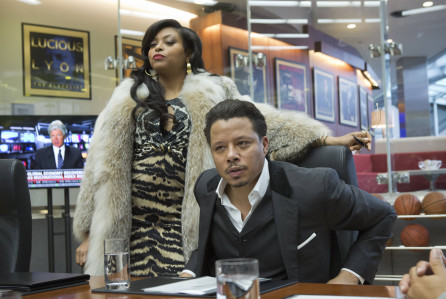available for purchase
at this time.
Link Roundup! – 3/27/15
Link Roundups feature articles and bits of internet goodness that our dramaturgy team digs up. If you find something you want to send our way, drop us a line on Facebook or Twitter!
♦♦♦♦♦

Peter Friedman, Danny McCarthy, Michael Countryman, Hannah Bos and Carolyn McCormick in “The Open House” by Will Eno at Signature Theatre. (Photo by Joan Marcus)
In American Theatre, Issac Butler writes about several contemporary playwrights who are taking the traditional realistic living room family drama and turning it on its head:
In the current crop of anti-realist plays are Eno’s The Open House and Jacobs-Jenkins’s Appropriate, both mounted last season at New York City’s Signature Theater, and Young Jean Lee’s Straight White Men, a recent critical success at the Public Theater. Next season, Taylor Mac’s Hir will have its East Coast debut at Playwrights Horizons. All these plays simultaneously deploy and subvert various tropes of the genre: difficult fathers, family secrets, eccentric mothers, a compressed time scheme, money worries—and, well, white people.
They’re also all set in and around living rooms, the most common and persistent setting in contemporary American theatre.
While it can be frustrating to walk into a theatre and see yet another couch in front of yet another television three feet away from yet another cluttered bookshelf, the ubiquity of this setting isn’t hard to understand. After all, the living room’s history and linguistic roots intersect with American theatre’s primary concerns. “Living room” is simply the American term for the parlor, whose name derives from the French parler, to talk. It is figuratively, then, a space for talking. Parlors are also a middle-class (or, if you must, bourgeois) invention, much like the theatres that regularly reproduce them onstage.
♦♦♦♦♦
Jason Tseng, the Community Engagement Specialist at Fractured Atlas, has a compelling essay up at Medium about LA’s 99-seat Theatre Plan and the issue of funding for small companies:
The top 3% of arts organizations by budget size ($10M and above) received 60% of all arts and culture funding. Conversely, the bottom half of organizations by budget size ($100k and below) received only 5% of that funding.
Not only is this deeply problematic from a purely class perspective, Holly also notes that this wealth gap disproportionately effects racial and ethnic minority communities, as well as other oppressed groups. This phenomenon is also not limited to the U.S. In fact, a similar report out of Britain cautioned that drastic changes to arts funding need to occur in order to avoid a “cultural apartheid.”
♦♦♦♦♦
There were a lot of responses to this recent and very problematic Deadline article about the increase in opportunities for actors of color in Hollywood, but Howard Sherman’s critique is an especially great and necessary take-down:
Through my role at the Alliance for Inclusion in the Arts, I can attest to the fact that television networks are absolutely seeking to diversify the stories they tell. In our nearly 30 year history of advocating for diversity in race, culture and ethnicity in film, television and theatre, we’re often consulted on these issues, and have been continuously by the networks and other entertainment sources. They haven’t advised us of any quotas they’re trying to fill, but they’re also not solely focused on race; the number of calls seeking to tap our database of artists with disabilities has also seen a marked increase.
Andreeva treats efforts at diversity as a trend, a response to successful shows with actors of color in lead roles (How To Get Away With Murder), and shows that focus on stories about non-Caucasian principals (Empire, Black-ish, Fresh Off The Boat). To be sure, no one can accuse the entertainment industry of not seeking to recreate success through imitation, but their commitment to diversity seems to go deeper than that. Yet Andreeva doesn’t fully address to economic imperative of doing so: the fact that America is on a rapidly accelerating pace towards seeing Caucasian as only 50% of the population within the next 30 years. The networks are, for once, ahead of the curve, rather than following it.
(This list of 8 Diverse TV Shows to Watch is worth checking out as well!)
♦♦♦♦♦
This Guardian article about re-imagining digital innovation is a good reminder to use the already present strengths of your organization:
Innovation means looking at digital channels not as generic marketing outlets, but as routes to different audiences with niche interests and needs. It also means thinking about whether the content is fit for our audiences’ purposes – not our own. To do so arts organisations must shape their content to be editorially relevant, technically portable and design-sensitive.
It’s about what’s next as well. Digital innovation is about building organisational capacity to support the creation of innovative digital projects in the future.
However, capacity-building for innovation is less about changing organisational setup and technical infrastructure, and more about developing people, their confidence, skills and working practices.

